What is Permanent Tissue?
- Permanent tissue refers to a category of plant tissue characterized by cells that have ceased to divide. Unlike meristematic tissues, which are composed of undifferentiated cells capable of continuous division, permanent tissues consist of mature cells that have completed their developmental processes and adopted specific roles within the plant.
- The formation of permanent tissue follows the process of cellular differentiation, wherein meristematic cells transition into specialized cells with distinct shapes, sizes, and functions. This differentiation results in cells that are structurally and functionally adapted to perform particular roles necessary for the plant’s survival and functionality. These roles might include structural support, nutrient storage, or protection.
- Cells within permanent tissues exhibit a lower metabolic rate compared to their meristematic counterparts. They often have a fixed shape and size, and their primary functions are tailored to the needs of the plant. The nature of permanent tissue can be living or dead. For example, xylem cells, which are part of the complex permanent tissue, can become lignified and function to transport water and nutrients, but they eventually die and form part of the plant’s supportive framework.
- Permanent tissues are categorized into two main types: simple and complex. Simple permanent tissues consist of a single type of cell and include parenchyma, collenchyma, and sclerenchyma. Each of these types serves distinct functions, such as storage of nutrients (parenchyma), structural support (collenchyma), or mechanical support and protection (sclerenchyma).
- Complex permanent tissues, on the other hand, are composed of multiple types of cells working together to perform a specific function. Examples include xylem and phloem. Xylem tissue facilitates the transport of water and dissolved minerals from the roots to other parts of the plant, while phloem is responsible for the distribution of organic nutrients.
Definition of Permanent Tissue
Permanent tissue is a type of plant tissue composed of mature, differentiated cells that have lost the ability to divide and have specific functions, such as support, storage, or transport.
Characteristics of Permanent Tissue
- Differentiation:
- Defined Structure: Permanent tissues have differentiated into specific cell types with specialized functions. Unlike meristematic tissues, they do not divide actively.
- Specialization: Each type of permanent tissue has a unique structure tailored to its function, such as support, transport, or storage.
- Cell Structure:
- Cell Wall Composition: The cell walls of permanent tissues are often thicker and more rigid compared to those in meristematic tissues. They may contain substances like lignin, cellulose, or pectin, depending on the tissue type.
- Vacuole Size: Permanent tissue cells typically have large central vacuoles that contribute to turgor pressure and storage functions.
- Functionality:
- Non-Meristematic: Once cells become part of permanent tissues, they generally cease to divide. Their main role is to perform specific functions such as support, nutrient transport, or storage.
- Adaptation to Function: The cells are adapted to their function, whether it’s mechanical support (as in sclerenchyma), flexible support (as in collenchyma), or nutrient storage (as in parenchyma).
- Types of Permanent Tissues:
- Simple Permanent Tissues: These consist of one type of cell and include:
- Parenchyma: Involved in storage, photosynthesis, and tissue repair.
- Collenchyma: Provides flexible support, mainly in growing parts of the plant.
- Sclerenchyma: Offers mechanical support and strength, with cells often lignified and dead at maturity.
- Complex Permanent Tissues: These are made up of multiple cell types working together, including:
- Xylem: Responsible for water and nutrient transport; composed of tracheids, vessels, xylem fibers, and xylem parenchyma.
- Phloem: Transports organic nutrients; consists of sieve tubes, companion cells, phloem fibers, and phloem parenchyma.
- Simple Permanent Tissues: These consist of one type of cell and include:
- Location:
- Tissue Distribution: Permanent tissues are distributed throughout various parts of the plant, including stems, leaves, roots, and flowers. Their location is closely related to their function.
- Lack of Active Division:
- Non-Active Growth: Cells in permanent tissues do not actively divide. They are fully differentiated and perform specific roles for the life of the plant.
Types of Permanet Tissue
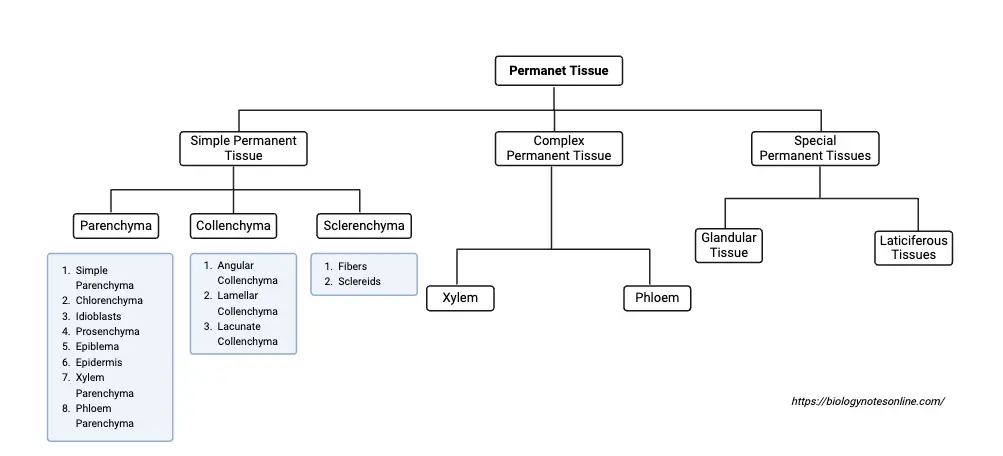
A. Simple Permanent Tissue
Simple permanent tissues are a category of plant tissues comprised of cells of a single type, which are specialized to perform specific functions. These tissues are also referred to as homogeneous tissues due to their uniform cellular composition. They are classified into three main types: parenchyma, collenchyma, and sclerenchyma. Each type has distinct characteristics and functions essential for plant structure and growth.
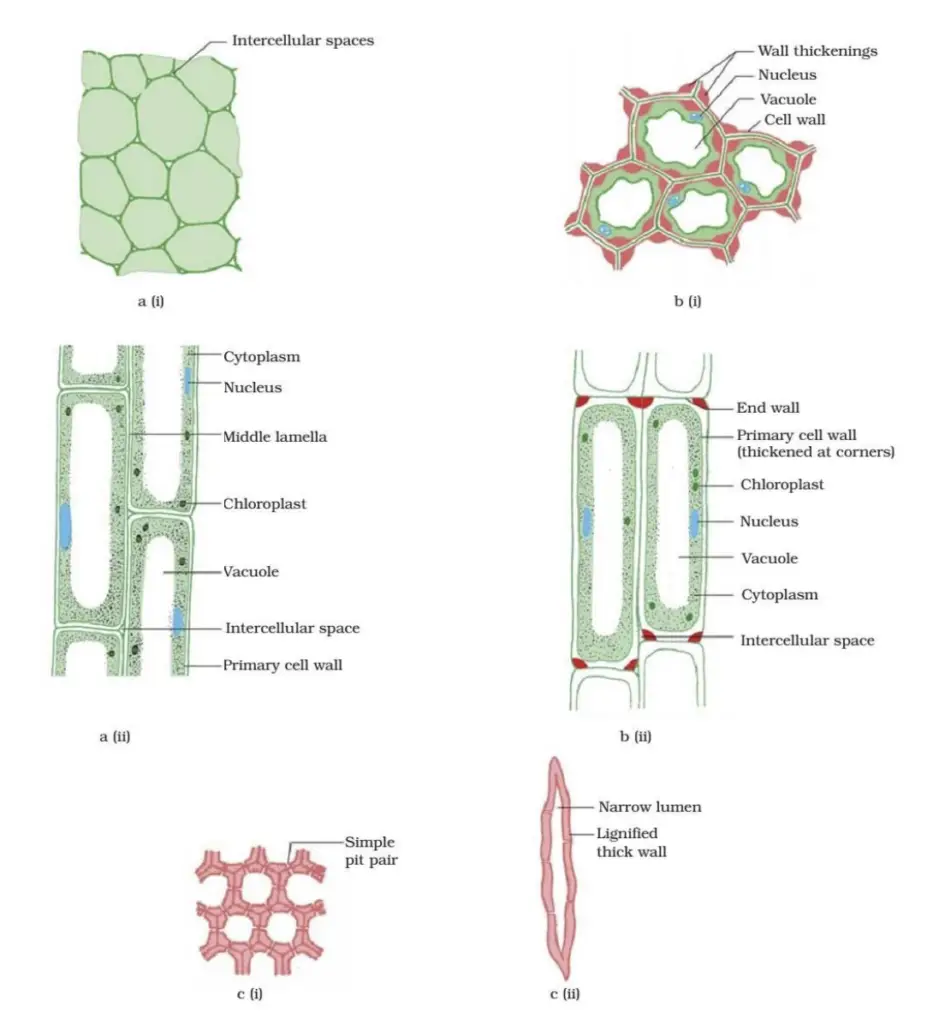
1. Parenchyma
Parenchyma tissue represents a fundamental type of permanent tissue found across all plant species. This tissue is characterized by its composition of unspecialized, living cells, which are crucial for various physiological functions. Derived from the Greek terms “para” meaning beside and “enchyma” meaning tissue, parenchyma refers to the “beside tissue” that is integral to plant function and structure.
Characteristics of Parenchyma Tissue
- Cell Structure:
- Cell Shape: Parenchyma cells generally exhibit an isodiametric shape, though they can also be oval, polygonal, or rounded.
- Cell Walls: The cell walls are thin and primarily composed of cellulose, hemicellulose, and pectin.
- Intercellular Spaces: These cells possess intercellular spaces that facilitate various physiological processes.
- Vacuoles: Parenchyma cells contain large central vacuoles, which play a role in storage and maintaining cell turgor pressure.
- Living Cells:
- All cells within parenchyma tissue are living at maturity.
- The cells are capable of mitotic division, aiding in the regeneration of damaged plant parts.
- Distribution:
- Parenchyma tissue is ubiquitous in plants, forming the bulk of plant organs such as fruits, stems, and leaves.
Types of Parenchyma Tissue
- Simple Parenchyma:
- Description: Characterized by thin-walled, isodiametric cells with intercellular spaces.
- Location: Found in the pulp of fruits, cortex, medullary rays, and the pith of plant organs.
- Function: Contributes to storage and general metabolic functions.
- Chlorenchyma:
- Description: A specialized form of parenchyma rich in chloroplasts.
- Location: Present in green plant tissues such as leaves, young stems, and flower sepals.
- Function: Engages in photosynthesis, converting light energy into chemical energy.
- Idioblasts:
- Description: Parenchyma cells that contain specialized inclusions like oil droplets or calcium oxalate crystals.
- Function: Primarily involved in storage of substances such as oils and tannins.
- Prosenchyma:
- Description: Parenchyma cells with thickened walls and elongated shapes, tapering at the ends.
- Location: Found in the pericycle of some plants.
- Function: Provides mechanical support to plant structures.
- Epiblema:
- Description: The outermost layer of root tissues, consisting of thin-walled parenchyma cells with no intercellular spaces.
- Function: Facilitates root absorption and may produce root hairs.
- Epidermis:
- Description: The outermost layer of the aerial parts of plants, composed of tightly packed parenchyma cells.
- Function: Protects plant tissues and may feature a cuticle layer to reduce water loss.
- Xylem Parenchyma:
- Description: Parenchyma cells associated with xylem tissue.
- Function: Assists in the storage of nutrients and the lateral conduction of water and minerals.
- Phloem Parenchyma:
- Description: Parenchyma cells associated with phloem tissue.
- Function: Helps in the storage and lateral conduction of organic nutrients.
Functions of Parenchyma Tissue
- Storage: Parenchyma tissues are crucial for storing various substances, including water, fats, and oils.
- Transport: They play a role in the transport of nutrients and other chemical products within the plant.
- Photosynthesis: In chlorenchyma cells, parenchyma is involved in the process of photosynthesis, which is essential for plant energy production.
- Regeneration: The ability of parenchyma cells to divide and form new cells supports the regeneration of plant tissues.
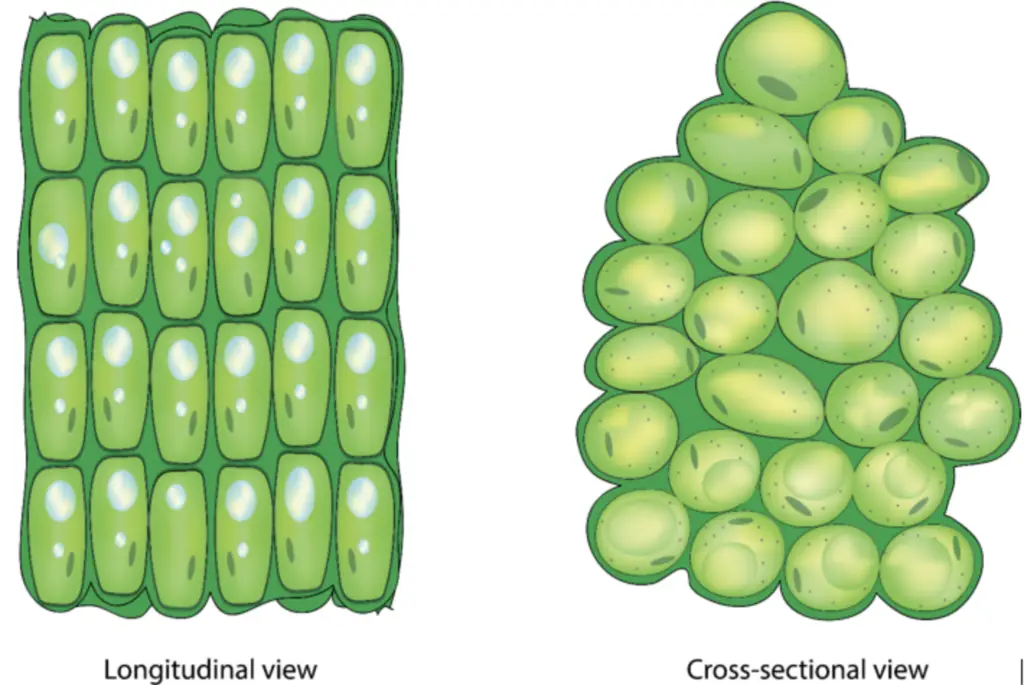
2. Collenchyma
Collenchyma tissue is a type of supportive plant tissue that plays a critical role in providing mechanical support and flexibility. The term “collenchyma” originates from the Greek words “colla,” meaning gum, and “enchyma,” meaning tissue. This reflects the tissue’s structure and function, which are essential for plant growth and stability.
Characteristics of Collenchyma Tissue
- Cell Structure:
- Cell Shape: Collenchyma cells are typically elongated and can be spherical or oval in shape.
- Cell Walls: The primary cell walls are thickened, primarily due to the deposition of cellulose and pectin. This thickening is uneven, with the corners of the cells showing more significant thickening compared to the centers.
- Refractive Index: The high content of pectin contributes to a high refractive index in these cells.
- Intercellular Spaces: The cells are packed closely together, resulting in the absence of intercellular spaces.
- Cell Life:
- Living Cells: Collenchyma cells remain alive when mature, which distinguishes them from other types of plant cells that may become lignified or die.
- Tissue Location:
- Distribution: Collenchyma is found in the epidermis and vascular bundles of dicot leaves. It is also present in the stems of herbaceous dicotyledons, forming a layer known as the hypodermis.
Types of Collenchyma Tissue
- Angular Collenchyma:
- Description: Characterized by uniform thickening on all sides of the cell due to the deposition of cellulose and pectin.
- Function: Provides strength and support by reinforcing all sides of the cells.
- Lamellar Collenchyma:
- Description: Features thickened tangential walls, while the other walls remain less thickened.
- Function: Contributes to tensile strength along specific directions.
- Lacunate Collenchyma:
- Description: Contains lacunae (spaces) within the tissue, with thickened walls around these spaces.
- Function: Provides both structural support and some flexibility due to the lacunae.
Functions of Collenchyma Tissue
- Support and Flexibility:
- Mechanical Support: Collenchyma tissue provides mechanical strength to plant parts, which is crucial for supporting young and growing plant organs.
- Flexibility: The tissue’s ability to stretch and expand helps accommodate growth and movement in plants.
- Photosynthesis:
- Chloroplast Presence: Some collenchyma cells contain chloroplasts, allowing them to contribute to photosynthesis, especially in the green parts of plants.
- Protection:
- Leaf Margins: Collenchyma helps protect leaf margins from physical damage, reducing the likelihood of tearing.
3. Sclerenchyma
Sclerenchyma tissue is a vital component of the plant’s structural framework, contributing significantly to its mechanical strength and support. The term “sclerenchyma” derives from the Greek words “sclerous” meaning hard, and “enchyma” meaning tissue. This tissue is characterized by its hard, thick-walled cells which are crucial for the plant’s rigidity and protection.
Characteristics of Sclerenchyma Tissue
- Cell Structure:
- Cell Shape and Size: Sclerenchyma cells are typically long, narrow, and fiber-like. They are often pointed at both ends and exhibit a variety of shapes, including cylindrical, T-shaped, and stellate forms.
- Cell Walls: The walls are thickened due to the deposition of lignin, a complex polymer that imparts hardness and rigidity. Both primary and secondary cell walls are present, with the secondary wall being significantly thicker and containing pits for gas transfer.
- Lignification: The secondary cell wall, rich in lignin, is crucial for the mechanical strength of these cells.
- Intercellular Spaces: There are no intercellular spaces between sclerenchyma cells, as they are tightly packed to provide structural support.
- Cell Life:
- Dead Cells: Sclerenchyma cells are dead at maturity. They do not have metabolic activities and cannot multiply or stretch.
- Distribution:
- Location: Sclerenchyma is found in various parts of the plant, including the shells of nuts, fibers in wood, and other hard structures.
Types of Sclerenchyma
- Fibers:
- Description: Fibers are elongated cells with tapered ends and a thick secondary wall. They are dead at maturity and have a narrow lumen.
- Function: These cells provide tensile strength and support to plant tissues. They are commonly found in the vascular bundles, supporting elements like xylem and phloem.
- Sclereids:
- Description: Sclereids exhibit diverse shapes such as spherical, oval, cylindrical, T-shaped, dumbbell-shaped, or stellate. Their walls are thick and often show simple pits.
- Function: Sclereids are found in the hard parts of plants, such as the seed coats and fruit shells. They contribute to the toughness and protection of these structures.
Functions of Sclerenchyma Tissue
- Mechanical Support:
- Structural Integrity: The primary function of sclerenchyma is to provide mechanical support and rigidity to the plant. This is essential for maintaining plant structure and resisting external forces.
- Protection:
- Protective Coatings: Sclerenchyma forms protective layers around seeds and nuts, enhancing their durability and resistance to physical damage.
- Water Conservation:
- Waxy Coating: Sclerenchyma may contribute to the formation of a waxy coating on leaves, which helps in reducing water loss and protecting against desiccation.
Difference between Sclerenchyma, Parenchyma and Collenchyma

| Aspect | Sclerenchyma | Parenchyma | Collenchyma |
|---|---|---|---|
| Primary Function | Mechanical support and protection | Storage, photosynthesis, and tissue repair | Support and flexibility, particularly in growing tissues |
| Cell Wall Structure | Thick, lignified secondary walls | Thin primary walls only | Thickened primary walls with cellulose and pectin |
| Cell Types | Fibers and sclereids | Various types including parenchyma cells | Elongated cells with varying wall thickening |
| Living or Dead Cells | Mostly dead (sclerenchyma fibers and sclereids) | Living cells | Living cells |
| Cell Shape | Long, narrow, or irregular | Various shapes including spherical, oval, etc. | Elongated, often with uneven wall thickness |
| Presence in Plant | Found in hard parts like shells, fibers, wood | Found throughout the plant in all tissues | Found in stems, leaves, and petioles |
| Function in Support | Provides rigid support and strength | Minimal structural support | Provides flexible support and strength |
| Nutrient Storage | Limited to some sclerenchyma fibers | Often involved in storage of starch, fats, and water | Typically not involved in nutrient storage |
| Repair Mechanism | No significant repair role | Involved in tissue repair and regeneration | Minimal repair function |
| Special Features | Thickened walls with lignin, often dead cells | Thin-walled, versatile cells with living protoplasts | Thickened cell walls mainly at corners |
B. Complex Permanent Tissue
Complex permanent tissues are specialized structures in vascular plants responsible for the efficient transport of water, nutrients, and organic compounds. These tissues consist of multiple cell types that work cohesively to perform their functions. They are primarily categorized into two types: xylem and phloem.
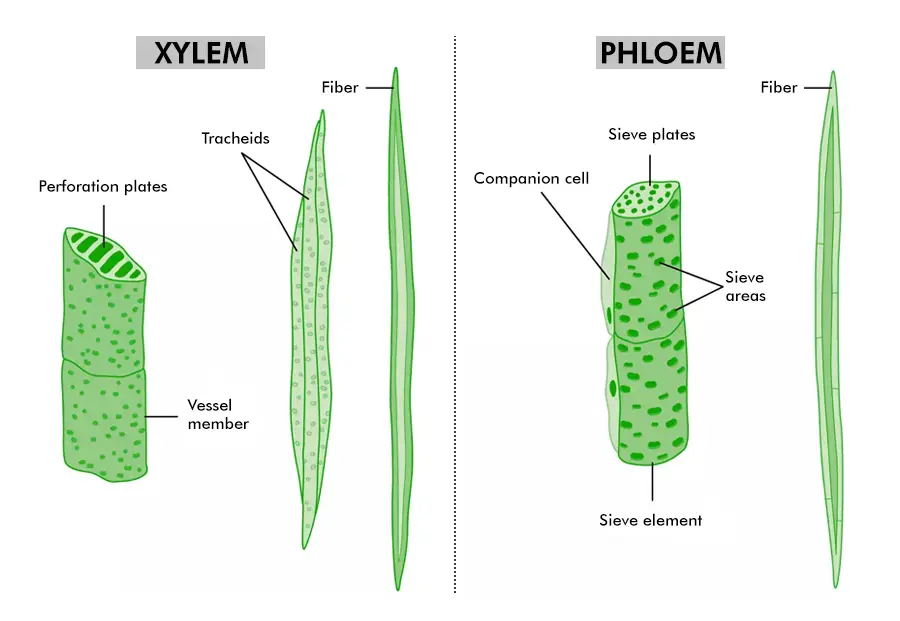
1. Xylem
Xylem is the chief tissue responsible for the conduction of water and inorganic solutes from the roots to the rest of the plant. It plays a critical role in providing mechanical support and facilitating the upward movement of water.
Characteristics of Xylem:
- Cell Types:
- Tracheids: Elongated, tube-like dead cells with tapered ends. Their cell walls are lignified, providing structural support.
- Vessels: Composed of rows of elongated dead cells aligned end-to-end. The transverse walls are dissolved, forming continuous tubes that facilitate water transport.
- Xylem Parenchyma: Living cells that store nutrients and aid in repair and regeneration.
- Xylem Fibers: Provide additional mechanical strength.
- Cell Walls:
- Composition: The walls are primarily composed of cellulose and lignin.
- Structure: The secondary cell walls are heavily lignified, contributing to the rigidity and strength of the tissue.
- Functionality:
- Water Transport: Xylem conducts water and dissolved minerals from roots to other plant parts.
- Mechanical Support: Provides structural reinforcement to the plant.
Functions of Xylem:
- Transport:
- Facilitates the upward movement of water and inorganic solutes from the roots to various plant parts.
- Storage:
- Stores nutrients such as starch, fats, and tannins within xylem parenchyma cells.
- Repair and Protection:
- Aids in the repair of blocked vessels and prevents damage during water scarcity by reducing stress on the vascular tissues.

2. Phloem
Phloem is responsible for the distribution of organic nutrients, primarily carbohydrates produced during photosynthesis, throughout the plant. It ensures the transportation of these nutrients both upwards and downwards.
Characteristics of Phloem:
- Cell Types:
- Sieve Tubes: Long, tubular cells without nuclei, essential for nutrient transport. They are connected end-to-end to form continuous channels.
- Companion Cells: Elongated cells with a large nucleus that assist sieve tubes in the transport process.
- Phloem Fibers: Provide mechanical support to the phloem tissue.
- Phloem Parenchyma: Living cells involved in storage and repair functions.
- Cell Walls:
- Composition: The cell walls are thin and composed mainly of cellulose.
- Structure: Sieve tubes have porous end walls facilitating the flow of sap.
- Functionality:
- Nutrient Transport: Phloem moves carbohydrates and other organic nutrients from the leaves to other parts of the plant.
- Support: Phloem fibers contribute to the structural support of the plant.
Functions of Phloem:
- Nutrient Distribution:
- Transports the products of photosynthesis from source regions (leaves) to sink regions (roots, fruits, and other growing tissues).
- Mechanical Support:
- Provides support through phloem fibers and helps maintain plant structure.
- Sap Transport:
- Facilitates the movement of sap, which contains dissolved nutrients and hormones.
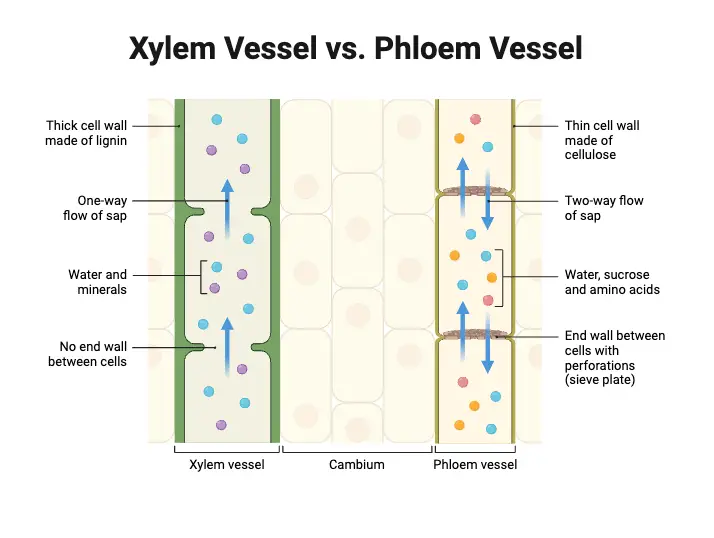
Difference between Xylem and Phloem
| Aspect | Xylem | Phloem |
|---|---|---|
| Primary Function | Transport of water and inorganic nutrients | Transport of organic nutrients (carbohydrates) |
| Direction of Flow | Unidirectional (upwards from roots to leaves) | Bidirectional (upwards and downwards) |
| Cell Types | Tracheids, vessels, xylem fibers, xylem parenchyma | Sieve tubes, companion cells, phloem fibers, phloem parenchyma |
| Cell Walls | Thick and lignified (cellulose and lignin) | Thin and primarily cellulose |
| Living or Dead Cells | Mostly dead cells (tracheids and vessels) | Mostly living cells |
| Cell Structure | Elongated, with lignified secondary walls | Tubular, with porous end walls |
| Function in Support | Provides mechanical support to the plant | Provides some support but primarily for transport |
| Nutrient Storage | Stores nutrients like starch and tannins | Does not store nutrients significantly |
| Repair Mechanism | Helps in repair of blocked vessels | Helps in translocation and minor repair |
| Presence in Plant Parts | Found in stems, roots, and leaves | Found in stems, leaves, and phloem tissues |
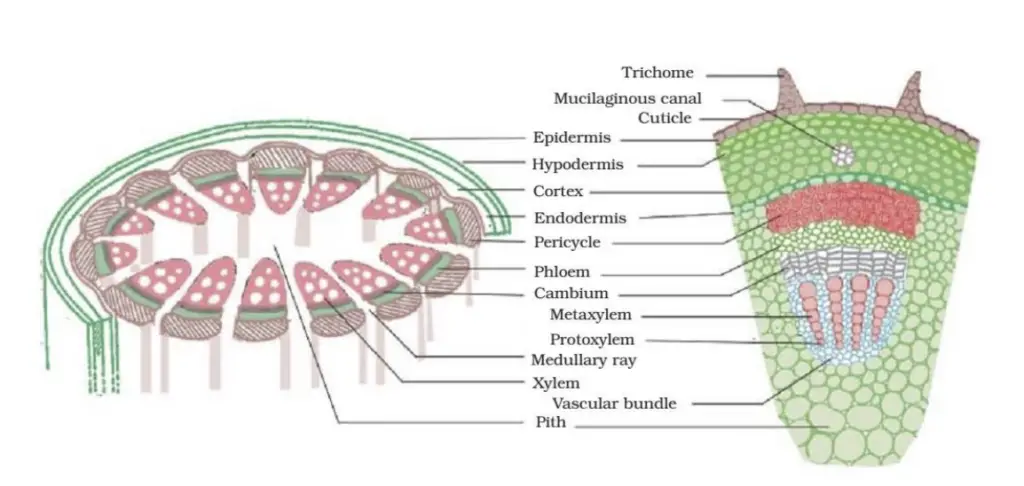
C. Special Permanent Tissues
Special permanent tissues in plants are distinct from other types due to their structural modifications and specific functions. These tissues are specialized to carry out particular roles essential for plant survival and adaptation. Two primary categories of special permanent tissues are glandular tissues and laticiferous tissues. Each type has unique characteristics and functions, contributing to the plant’s overall physiology.
1. Glandular Tissue
Glandular tissue is characterized by the presence of specialized glands that are either single cells or clusters of similar cells. These glands are predominantly found on the epidermis of plants.
- Structure and Composition:
- Glandular tissues are composed of gland cells, which can be single or organized into groups.
- The glands may vary in shape and size depending on their specific functions and locations.
- Functions:
- Secretion: The primary function of glandular tissue is the secretion of various substances, such as resins, oils, and other secretions.
- Protection: By producing substances like resins, glandular tissues can help protect the plant from pathogens and herbivores.
- Attraction: Some secretions attract pollinators or aid in seed dispersal.
- Examples:
- Resin Glands: These secrete a sticky substance that can deter herbivores and seal wounds.
- Oil Glands: Found in citrus fruits and some other plants, these glands produce essential oils.
2. Laticiferous Tissues
Laticiferous tissues are specialized for the production and secretion of latex, a milky fluid that serves various functions in plants.
- Structure and Composition:
- Cell Arrangement: Laticiferous tissues consist of elongated cells with thin walls, often containing multiple nuclei.
- Origin: These tissues originate from meristematic tissues and undergo differentiation to perform their specific functions.
- Functions:
- Latex Production: The main function of laticiferous tissues is to produce and secrete latex, which can serve as a defense mechanism or play a role in the plant’s reproductive processes.
- Protection: Latex can deter herbivores due to its sticky and sometimes toxic nature.
- Wound Healing: The latex may also aid in sealing wounds and preventing pathogen entry.
- Examples:
- Rubber Trees (Hevea brasiliensis): Known for their latex production, which is harvested for rubber.
- Milkweed (Asclepias spp.): Produces latex that is toxic to many herbivores.
Difference between Glandular Tissue and Laticiferous Tissues
| Feature | Glandular Tissue | Laticiferous Tissues |
|---|---|---|
| Function | Secretion of substances like resin, oil, or nectar. | Production and secretion of latex. |
| Cell Structure | Consists of single cells or groups of similar cells forming glands. | Composed of elongated cells with multiple nuclei. |
| Location | Found on the epidermis and various plant organs. | Located in specific tissues, such as in roots and stems. |
| Types of Secretions | Produces resin, oil, mucilage, or other specialized substances. | Produces latex, which is a complex mixture of compounds. |
| Cell Wall | Typically thin, allowing for secretion of materials. | Cells have thin walls but are specialized for latex production. |
| Development | Formed from differentiation of meristematic cells into glandular cells. | Develops from meristematic tissue into specialized laticifer cells. |
| Examples | Nectar glands in flowers, resin ducts in conifers. | Latex vessels in rubber trees, milky latex in euphorbias. |
| Function in Plant | Provides protection, attracts pollinators, or stores substances. | Acts as a defense mechanism and can aid in wound healing. |
Functions of Permanent Tissue
- Parenchyma:
- Storage:
- Nutrient Storage: Stores various nutrients such as starch, oils, and proteins in specialized cells called storage parenchyma.
- Water Storage: In some plants, parenchyma cells serve as water storage tissues, particularly in succulents.
- Photosynthesis:
- Chloroplast Containing: Parenchyma cells in the leaves and stems contain chloroplasts and participate in photosynthesis.
- Tissue Repair and Regeneration:
- Wound Healing: Plays a role in wound healing and regeneration of plant tissues by differentiating into other types of cells as needed.
- Storage:
- Collenchyma:
- Support and Flexibility:
- Mechanical Support: Provides flexible support to growing parts of the plant such as young stems and leaves.
- Strength in Growth Areas: Located in areas of active growth, helping the plant withstand mechanical stress.
- Protection:
- Leaf Margins: Protects leaf margins and other sensitive parts from damage.
- Support and Flexibility:
- Sclerenchyma:
- Mechanical Support:
- Strength and Rigidity: Provides structural support and rigidity to various parts of the plant, including stems, roots, and leaves.
- Lignification: Cells are often lignified, which contributes to their strength and durability.
- Protection:
- Hard Structures: Found in the protective coverings of seeds and nuts, providing protection against physical damage and predation.
- Mechanical Support:
- Xylem:
- Water Transport:
- Vertical Transport: Transports water and dissolved minerals from the roots to other parts of the plant, including leaves and stems.
- Nutrient Transport:
- Nutrient Distribution: Assists in the distribution of nutrients dissolved in water throughout the plant.
- Support:
- Structural Support: Provides mechanical support due to the lignified walls of xylem cells, contributing to the overall strength of the plant.
- Water Transport:
- Phloem:
- Nutrient Transport:
- Translocation: Transports organic nutrients, particularly sugars produced during photosynthesis, from the leaves to other parts of the plant, including roots and fruits.
- Nutrient Distribution:
- Bidirectional Flow: Facilitates the bidirectional flow of nutrients, ensuring that various plant parts receive the necessary sustenance for growth and development.
- Support:
- Mechanical Strength: Provides some mechanical support through its fibrous components.
- Nutrient Transport:
Examples of Permanent Tissue
- Parenchyma
- Leaf Mesophyll:
- Description: Comprises the bulk of the leaf’s interior and contains chloroplasts for photosynthesis.
- Function: Performs photosynthesis and assists in gas exchange.
- Potato Tuber:
- Description: Stores starch in parenchyma cells.
- Function: Acts as a storage organ for nutrients.
- Apple Fruit Flesh:
- Description: The fleshy part of an apple is made up of parenchyma cells.
- Function: Stores nutrients and contributes to the fruit’s texture and flavor.
- Leaf Mesophyll:
- Collenchyma
- Celery Stalk:
- Description: The strings in celery are composed of collenchyma cells.
- Function: Provides flexible support to the growing stalk.
- Leaf Petiole:
- Description: The petiole, or leaf stalk, often has collenchyma tissue in its outer layers.
- Function: Provides support and flexibility to the leaf.
- Young Stems:
- Description: The outer layers of young stems in many plants contain collenchyma cells.
- Function: Supports the stem while allowing for growth and movement.
- Celery Stalk:
- Sclerenchyma
- Hard Shell of Nuts:
- Description: The tough outer covering of nuts is made up of sclerenchyma cells.
- Function: Provides protection and mechanical support.
- Fibers in Cotton:
- Description: Cotton fibers are made of sclerenchyma cells.
- Function: Provides strength and flexibility to the fibers used in textiles.
- Wood:
- Description: Contains sclerenchyma cells in the form of xylem fibers.
- Function: Provides structural support and strength to the plant.
- Hard Shell of Nuts:
- Xylem
- Tree Trunk:
- Description: The trunk of a tree contains xylem cells, including tracheids and vessels.
- Function: Transports water and minerals from the roots to the rest of the tree and provides structural support.
- Roots:
- Description: Xylem in the roots transports water and nutrients from the soil.
- Function: Facilitates nutrient uptake and supports the plant’s overall stability.
- Branches:
- Description: Xylem vessels and tracheids in branches help transport water and support the plant’s structure.
- Function: Ensures the distribution of water and nutrients throughout the plant.
- Tree Trunk:
- Phloem
- Plant Stems:
- Description: Phloem tissues are present in the vascular bundles of plant stems.
- Function: Transports organic nutrients, such as sugars, from the leaves to other parts of the plant.
- Fruit Phloem:
- Description: The phloem in fruits helps transport nutrients to the developing seeds and fruit tissues.
- Function: Supports the growth and development of fruits and seeds.
- Potato Tubers:
- Description: Contains phloem tissue to transport nutrients to and from the tuber.
- Function: Plays a role in nutrient distribution and storage.
- Plant Stems:
References
- https://www.geeksforgeeks.org/permanent-tissues/
- https://www.davuniversity.org/images/files/study-material/EDU246%20BOTANY%202.pdf
- https://egyankosh.ac.in/bitstream/123456789/68174/1/Unit-1.pdf
- https://collegedunia.com/exams/permanent-tissue-biology-articleid-2309
- https://rltsc.edu.in/wp-content/uploads/2020/10/Permanent-Tissue-Simple-Tissue.pdf
- https://www.pmfias.com/plant-tissue-meristematic-simple-complex-permanent-tissue/
- https://www.geeksforgeeks.org/permanent-tissues-class-9-biology/
- http://www.lscollege.ac.in/sites/default/files/e-content/Pant%20tissues.pdf
- https://www.pw.live/chapter-biology-class-9-tissue/permanent-tissue
- https://webstor.srmist.edu.in/web_assets/srm_mainsite/files/downloads/PLANT_TISSUE.pdf
- https://www.embibe.com/exams/permanent-tissue/
- https://www.pw.live/chapter-anatomy-of-flowering-plants/permanent-tissues
- https://www.aakash.ac.in/important-concepts/biology/simple-permanent-tissue
- https://unacademy.com/content/nda/study-material/biology/tissues-plant-tissue-permanent-tissue/
Excellent note of plant tissues—clear and informative!
This was a great overview of permanent tissue in plants! I found the distinction between simple and complex permanent tissues particularly helpful. It would be nice to see some diagrams to illustrate the different types of tissues discussed
Good
Thank You